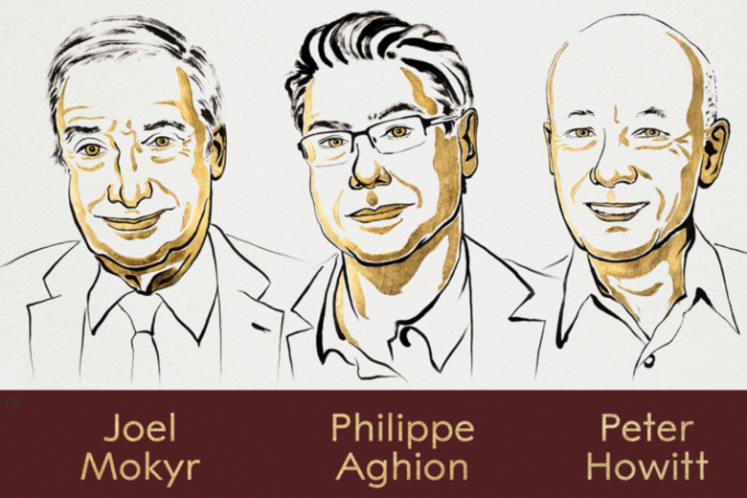The news that the 2025 Nobel Prize in Economics has been awarded to Joel Mokyr, Philippe Aghion and Peter Howitt for their work on the role of technological change in the process of sustained economic growth was welcomed with great enthusiasm at UNU-MERIT. The institute has been working for almost 40 years on this exact topic. Philippe Aghion and Peter Howitt participated at the 1992 conference that celebrated MERIT’s first lustrum (the conference also hosted Paul Romer, the 2018 laureate, and Ken Arrow, who had already received the Prize in 1972), and Joel Mokyr often visited if only to entertain his Dutch.
Schumpeter’s legacy and innovation economics
Much of the work in the innovation economics field, including that of the three laureates, goes back to the insights of Joseph Schumpeter (1883 – 1950), the Austrian economist and banker who pioneered the economic analysis of innovation and technological change. Schumpeter’s view was that of a “restless capitalism” in which innovation is a constant force that shakes up the economy. While academic economists are used to analysing the economy as a system in which the forces of competition lead to an equilibrium that maximizes welfare, the core of Schumpeter’s thinking is that this equilibrium can never be reached as long as innovation takes place.
The central idea in Schumpeter’s view is that major technological breakthroughs, such as the steam engine, the automobile or the computer, lead to long periods of economic growth. But this is not a frictionless process: restless capitalism has periods of booms as well as busts, and the rise of a new technology creates winners (those who invested in it at an early stage) and losers (those who are still invested in the old technology when the new one begins to spread). This is called “creative destruction” by Schumpeter: growth can only take place by destroying human and physical that is associated with the old technologies.
The laureates’ contributions
This year’s laureates have followed up on these ideas in different ways. Joel Mokyr (awarded half of the prize) is an economic historian whose main field of study is how technology develops in interaction with economic and societal change. His main contribution that inspired the prize committee is that he identifies sustained economic growth with the factors that stimulated technological change since the Industrial Revolution that took place in the late 18th century in the UK. Much of his work focused on the question why the Industrial Revolution took place where and when it occurred.
On the other hand, Philippe Aghion and Peter Howitt (jointly awarded the other half) are economic modellers who presented a growth model in which Schumpeter’s idea of “creative destruction” was incorporated, albeit in a context of equilibrium. In their model, technological change takes the form of vertical product differentiation, which is the modellers’ terminology for saying that each new innovation replaces the previous one. This implies that innovation has positive as well as negative externalities and, consequently, that there may also be too much innovation.
Another way in which Aghion and Howitt explained their model of innovation was that each innovation “stands on the shoulders of giants”. This is a well-known phrase that not only applies to the Aghion & Howitt growth model, but also to science more generally. In this sense, while each Nobel Prize draws attention to the extraordinary work of the Prize winners, it also signals the role of the broad academic community in which this work takes place.
This makes this year’s Nobel Prize in economics special for Maastricht, SBE and UNU-MERIT in particular, because there are so many direct linkages to our local context. The founding fathers of SBE opted for a research specialization of the new faculty in the economics of technological change and innovation, together with labour economics and the economics of the public sector. The innovation and technological change keywords became formally acknowledged in the ‘MERIT’ acronym of the institute set up in 1988.
Local significance for Maastricht, SBE, and UNU-MERIT
As authors of this reflection, our own academic lives are irrevocably connected with this (local) community of innovation economists, and this year’s Nobel prize in economics represents, to us, also a belated recognition of strategic research choices made in the 1980s, as well as the work done by the community in the decades to follow. Among those who worked with us in (UNU-)MERIT was, for example, Chris Freeman (1921 – 2010), who co-developed a theory of Schumpeterian long waves of economic development that extends into broader economic factors than just growth. It also includes Richard Nelson (1930 – 2025), who received a doctorate honoris causa from UM in 1991, for his work on the micro- and industry-level foundations of restless capitalism. Paul David (1935 – 2023), who worked extensively on the history of technological change in the US and in Europe, was another valued member of the UNU-MERIT community. We are proud that this year’s giants Joel Mokyr, Philippe Aghion and Peter Howitt are supported by such a large group of broad shoulders, from Maastricht and elsewhere, whose academic journey we were happy to share over the past 40 years.
Read the original article on Maastricht University's website.
Suggested citation: Soete Luc, Verspagen Bart., "A reflection on the 2025 Nobel Prize in Economics- Giants and the shoulders they stand on," UNU-MERIT (blog), 2025-10-20, 2025, https://unu.edu/merit/blog-post/reflection-2025-nobel-prize-economics-giants-and-shoulders-they-stand.


